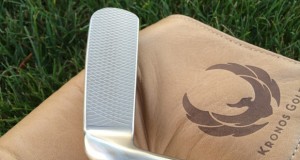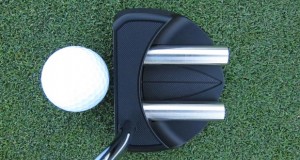 Just when you think you’ve seen it all in the world of putters, another newcomer arrives with fresh ideas about how to roll it into the hole. Such is the magnificent complexity of a fundamentally simple task.
Just when you think you’ve seen it all in the world of putters, another newcomer arrives with fresh ideas about how to roll it into the hole. Such is the magnificent complexity of a fundamentally simple task.
The latest entry in the race to build a better putter is Puku Golf of
Following is PutterZone.com’s review of the Puku JME model putter ($249, includes free shipping in the U.S. and an instructional DVD).
The Storyline
Puku Golf was founded by Simon Moore, an avid golfer and optometrist, who first started thinking about designing putters in 1985. Back then,
“Sometimes knowing nothing is a good place to start, because if you know nothing you assume nothing,”
The enthusiasm of a local club professional who tried
The result is a putter like no other—a striking instrument that is packed with a head-spinning array of features and benefits that are almost impossible to summarize in this short space. Here are some of the technological highlights that are exclusively unique to Puku Golf:
-Puku putters feature adjustable-length shafts that telescope between 31 inches and 39 inches. They can also be turned into adjustable-length belly putters with an optional separate belly putter grip.
-Puku putters are center balanced, which should not be confused with face balanced. According to the company, center balancing provides stability and gives perfect balance throughout the entire putting stroke. Says
-Puku putters feature a round reverse-tapered grip (meaning that it gets thicker as it extends down the shaft), whereas the traditional putter grip features a standard taper with a flattened edge along the front. According to the company: “A round grip fits better into your hands. When it sits in your lifeline, you have more of your palms in contact with the grip, and more contact will provide greater feel.”
Puku putters also feature double-milled faces for truer roll; heavier 420-gram heads for stroke stability; elegantly curved hosels that provided a clear view of the head at address; and raised Puku logos on the soles that help initiate a smooth backswing. Whew.
The View from PutterZone.com
I’ve always envisioned
So where to begin? Let’s start with the remarkable fact that I sank a ton of long putts during my initial test drive of the Puku putter. Talk about a great first impression.
I was particularly impressed by the putter’s resistance to twisting on miss hits, a quality that I must attribute to the center balancing. A lot of putters talk about high MOI and resistance to twisting and turning, but the Puku putter truly walks the talk. The result is phenomenal distance control and overall accuracy on long putts.
Ironically enough, it was the short putts that bedeviled me at first. Maybe that’s what happens when you wield a putter from Down Under? All I know is that the 420-gram head initially wanted run away from me at the transition point on shorter strokes, resulting in pushes and pulls. Unlike the Heavy Putter, the leader in the heavier putter category, the Puku JME does not have a weighted shaft insert for enhanced stability, nor does it have customizable weighting options.
However, as I got acquainted with the Puku JME’s swingweight behavior, the shorter putts started to come as well. My progress was aided by the reverse-tapered grip, which puts the stroke firmly in the control of the dominant hand while keeping the wrists quiet.
The lesson here is that you should expect to spend some time getting acclimated to the Puku putter. This is more of a compliment than a complaint. After all, the same could be said when switching from Microsoft Windows to Apple—because Apple, like Puku Golf, encourages you to “think different.”
The adjustable length is a nice feature, especially for those who want to experiment with different configurations. If you’re firmly committed to a particular putter length, however, adjustability fails to be a major selling point.
The Puku JME’s head is relatively large, yet manages to look slim and sleek. It is visually quiet at address, which aids confidence and concentration. The raised Puku logo on the sole is very hip, and the overall presentation seems a bit futuristic.
Oddly, this large putter makes a rather abrupt “tink” sound upon impact with the ball. At first, I found it troubling. In time, however, it put a smile on my face. After all, a putter this unique deserves its own unique sound. It’s not a TaylorMade or an Odyssey. It’s a Puku—and, I assure you, it sounds like a Puku.
The Bottom Line
The Puku JME is a piece of
 PutterZone – Best Putter Reviews
PutterZone – Best Putter Reviews




Hi there,
Just FYI, if anyone is looking for a Puku putter, we have re-released a limited number of them. Check out pukugolf.com for more info.
Cheers,
Jamie
Puku Golf
New Zealand